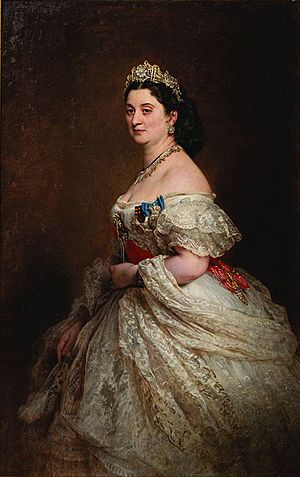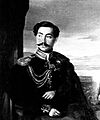Ekaterine Chavchavadze facts for kids
Quick facts for kids Ekateriné Dadiani-Chavchavadze |
|||||
|---|---|---|---|---|---|
| Princess of Mingrelia | |||||

Portrait by Franz Xaver Winterhalter
|
|||||
| Born | March 19, 1816 Tsinandali |
||||
| Died | August 25, 1882 (aged 66) | ||||
| Spouse | David Dadiani, Prince of Mingrelia | ||||
| Issue | Prince Niko Princess Salomé Prince Andria |
||||
|
|||||
| House | Chavchavadze | ||||
| Father | Prince Alexander Chavchavadze | ||||
| Mother | Princess Salomé Orbeliani | ||||
Ekateriné Dadiani (born Chavchavadze; March 19, 1816 – August 13, 1882) was a very important Georgian princess in the 1800s. She was the last ruling princess of the Principality of Mingrelia in Western Georgia. She served as a regent for her young son from 1853 to 1857. A regent is someone who rules a country when the rightful ruler is too young or unable to. Ekateriné played a big part in stopping the Ottoman influence in her land. She was also a central figure in Georgian high society, both in Georgia and in other countries.
Contents
Who Was Princess Ekateriné Dadiani?
Ekateriné was born into the Chavchavadze family, an important noble family from Eastern Georgia. Her father was Prince Alexander Chavchavadze, a famous Georgian general. He was also the godson of the powerful Russian Empress Catherine the Great. Ekateriné's mother was Princess Salomé Orbeliani. She was a great-granddaughter of Erekle II, a king of Eastern Georgia.
Ekateriné had two sisters. Her older sister, Princess Nino, married Aleksandr Griboyedov. He was a well-known Russian writer, musician, and diplomat. Her younger sister, Princess Sophie, married Count Alexandr Nikolai. He was the minister of education in Imperial Russia.
Ekateriné's Marriage and Role as Regent
On December 19, 1838, Ekateriné married David Dadiani. He was the prince who would inherit the throne of Mingrelia. In 1840, David became the ruler of the principality after his father, Levan V Dadiani, retired.
In August 1853, David passed away. Ekateriné quickly took over his responsibilities. The Russian Emperor Nicholas I of Russia recognized her as the regent for her oldest son, Prince Niko. He also set up a special council to help her rule. This council included her late husband's brothers, Prince Grigol Dadiani and Prince Konstantin Dadiani.
Challenges During the Crimean War
During the Crimean War, the Turkish army sent many soldiers to Mingrelia. They took over large parts of the principality. This forced Ekateriné to leave for safety. She soon got a threatening letter from the Turkish general, Omar Pasha. He demanded that she surrender and give her son's principality to the Ottoman Empire.
Ekateriné refused to answer Pasha's letter. Instead, she took charge of the Mingrelian forces. She organized successful counter-attacks that caused serious damage to the invading Turks.
The Crimean War ended in 1856 with the Treaty of Paris, a peace treaty. Ekateriné was put back in charge as regent. She was invited to the coronation (crowning ceremony) of Alexander II of Russia, the new Russian Emperor. She went to the ceremony with her children and her sister, Nino. A Russian writer named K.A. Borozdin said that Ekateriné was still very beautiful. He noted that she looked amazing in her "original and richly decorated costume." Many people in Georgia at the time called her the "Mingrelian Queen." Borozdin wrote that at the coronation ball, everyone was "delighted with [Ekateriné], her sister, children, and entourage."
Mingrelian Uprising and Russian Influence
In 1856, Ekateriné left the Mingrelian principality. She moved to Tsarskoye Selo, which was where the Russian Imperial Family lived. She became one of the "ladies of the court." But in 1857, she had to return to Georgia. This was because of a peasant uprising led by a Mingrelian blacksmith named Uta Miqava.
On May 12, the rebels took control of Zugdidi, the capital city. This forced Ekateriné to ask Russia for help. Russia had already taken over Eastern Georgia. They were eager to step in. They stopped the uprising and then asked Ekateriné to move to Saint Petersburg. They said it was to help with her children's education. Her leaving and Russia setting up a "temporary" military rule in Mingrelia meant that the principality was effectively ended.
Later Life and Legacy
After moving to Russia, Ekateriné continued to host her private salon in Tsarskoye Selo. A salon was a gathering where important people, like writers and thinkers, would meet and discuss ideas. She welcomed both Georgian and Russian intellectuals.
After living there for almost ten years, she moved to Paris. Her daughter, Princess Salomé, already lived there with her French husband, Prince Achille Murat. In her final years, Ekateriné moved back to Western Georgia. By then, it was officially part of the Russian Empire. She lived there until the end of her life. She was buried in the old Eastern Orthodox monastery of Martvili.
Children of Ekateriné Dadiani
Images for kids
-
Ekateriné at the coronation ball in the Winter Palace
-
Princess Ekateriné's salon in Tsarskoye Selo








